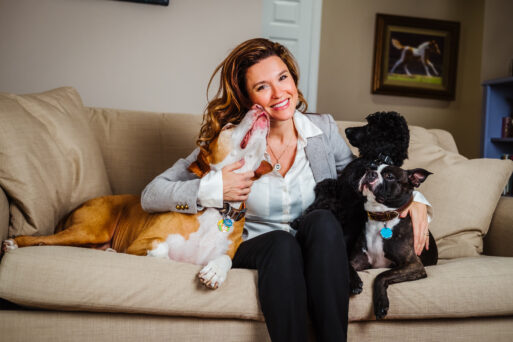
Dr. Dani McVety
Credit: Courtesy of Lap of Love
If you’ve ever had the privilege of loving a pet, you are probably familiar with how emotionally draining it can be when they get old. Because as a pet owner, you are inevitably confronted with the question of whether or not it is time to ease them through their final days with humane euthanasia, or to engage in medical interventions that would prolong their stay.
As it stands in the veterinary field, there isn’t a lot of guidance for vets on how to help owners navigate this delicate period of time. Dr. Dani McVety, DMV, picked up on this gap early on, recognizing that many of her peers had difficulty when dealing with this dilemma. So in 2009, she started Lap of Love, a nationwide network of passionate veterinarians that offer at-home hospice care and humane euthanasia.
Lap of Love is a family-focused, medically supervised, team-oriented service that is dedicated to maintaining the comfort and quality of life for terminally ill or senior pets until a natural death occurs or the family elects euthanasia. Their veterinary hospice care includes things like education about the end-stage disease process, symptom management, pain recognition and treatment, or mobility support.
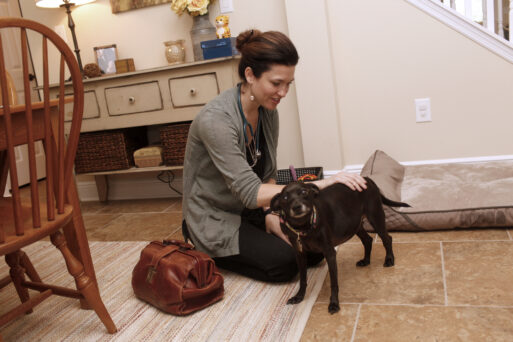
Dr. Dani at a Lap of Love client’s home
We spoke with Dr. McVety, (who often goes by Dr. Dani) about how she came up with the idea for Lap of Love, and how her veterinarians strive to empower every owner to provide the best care for their geriatric pets.
Editor’s Note: This interview has been edited for length and clarity.
Tell us a little bit about your background. How did you come to decide on this area of specialty?
When I was in college I volunteered for a human hospice program. When you volunteer, they walk you through an orientation training, and they do such a good job of preparing you for sitting with somebody who is facing the end of their days; like what to say, what not to say, and how to be empathetic with someone that maybe has a different faith system than you, or maybe no faith system at all. It was just very eye-opening. Then, in veterinary school, I never really felt like I was the strongest diagnostician. Instead, I found myself naturally gravitating towards a focus on my bedside manner. I wanted to be the veterinarian that clients raved about, the type of doctor my clients needed to see. So that’s how I stood out.
Then, when I graduated in 2009, I went into emergency medicine. The economy was collapsing at that time, and we saw a lot of people who came into the ER because they didn’t have any money. They put off going to the regular vet because they couldn’t pay for it, and then of course things got worse and worse, and boom, they’re in the emergency room. So there were a lot of euthanasias, and I quickly became the doctor that all the technicians would grab when that kind of case came in. I would talk to the family and follow up and answer their questions. And I loved it. I felt like I was finally finding my place.
I was only out of school for three months when I started Lap of Love. I just thought it would be a part-time thing that I would do here and there and then eventually buy into a practice. But within a year, it had grown so much that I had to stop my ER job, and it just kept growing and growing. This September will be 15 years since I started Lap of Love, and now we have over 600 employees. We’re helping close to 13,000 families a month.
In my experience it has been difficult to find a veterinarian who is comfortable with offering constructive advice when faced with a geriatric pet. How do you get around whatever it is that holds other veterinarians back in this situation?
I think what happens, particularly with young veterinarians, is you feel an ethical obligation to provide the animal with the best medicine possible. You also feel an ethical obligation to not suggest euthanasia. But what they forget is that there’s a big spectrum inside those two decisions!
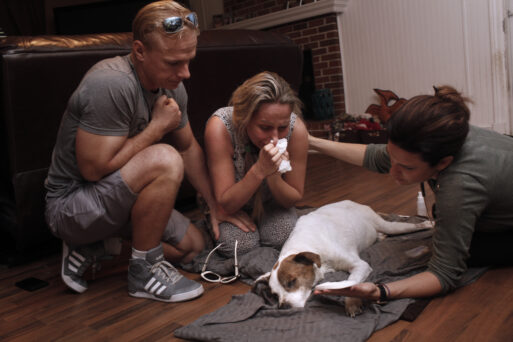
Dr. Dani with Lap of Love clients, in their home
You have to consider a lot of things when making that decision, so what I always loved to do was just sit there and ask questions. Like, “How would you feel about spending all the money [for medical treatment] and then maybe I can’t get your pet through surgery? What would it feel like if you didn’t try?” and so I would just kind of keep asking questions that got them to open up. And then, I felt like it was my duty to help them through the decision-making process and help them do it without guilt. Because, there’s a difference between “Well, you should spend that money because if you don’t you’ll be ridden with guilt,” or “Look, I understand this is maybe all the money you have. You might even go into debt, and I don’t want that for you – that’s not a necessary thing for you to do.” You have to gain rapport with family members first, of course, to know what they’re dealing with. But I took it upon myself to say those difficult things, help them consider all those aspects. And I know it meant so much to them.
When pets get more advanced in age sometimes it seems like they experience a medical domino effect, where they face more and more diagnoses and treatments. What do you counsel owners when they ask about where to draw the line?
It’s important for owners to understand that animals don’t have an emotional reaction to their pain the same way humans do. If you tell your human kid, “Okay, we’re going to have to do two years of internal medicine appointments and blood draws every time,” and that kind of stuff, that kid’s gonna go crazy. Or if you tell them, “Hey, we need to amputate your leg.” That’s a way different conversation with a human than it is for an animal. They don’t have an emotional attachment to their leg. Or to the pain they’re going through.
That means that we have to be very purposeful with pain management. Because they also can’t see a purpose to their pain the same way we can. So it kind of cuts both ways. People tend to think that dogs have this emotional roller coaster that they’re going through, but they don’t. They just live every minute, moment to moment.
So when we have a conversation about the pet’s quality of life, I always try to bring it back to the human’s perspective, too. How did they envision their pet’s final days? What are they most afraid of? And a lot of the time, they’re afraid of making the decision.
How so?
Some people will say they just want to come home and find their pet passed away. They don’t want to be the one making the decision that it’s time for their pet to die. But that’s when I will often tell them that that happened to me, and it made me feel so, so guilty. When your pet dies like that, you think you want it to happen, but once you do, you walk in and see them, you worry! Did you miss something? Were they in pain? What was the experience like for them? Were they screaming for two hours before you got there? You don’t know, and most of the time that’s even worse.
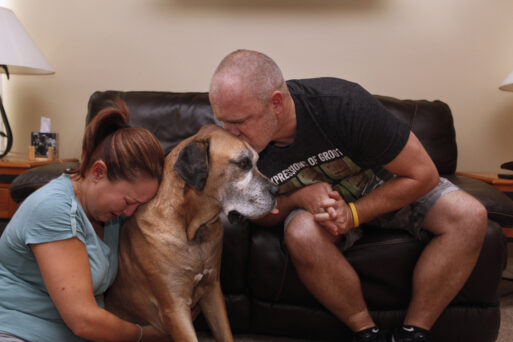
Many find it extremely difficult – but ultimately better – to be there with their pets at the end.
I remember this one lady, she wanted that scenario. She wanted to wait for the end to come “naturally.” And then she called me, frantic. She had come home to her dog collapsed and bleeding from the mouth and nose – still alive, but she didn’t know how long it had been like that. It was awful. It was traumatic – for both of them.
So that’s why it’s so important that families have someone to walk them through this process. As a vet, I help thousands of families go through this a year, but they’re only doing this a handful of times in their lives. So we walk them through every little step that they might not have considered and think ahead.
What are the most important things to consider, then, when it comes to that decision?
We call it the Four Budgets. There are four things that typically are going to influence a family’s decision.
The first is their monetary budget. I think that as veterinarians, we need to be really sensitive to the fact that somebody might not have the money to pursue certain avenues. And we don’t want them to feel guilty about that. It’s just the way life is.
Then there is time. You know, we might be saying, “We need to do this medication every four hours, and then we’re going to do this and that,” and you’ve got a single mom looking at you and maybe she just doesn’t have time to give a dog medication every six hours, and through the night; or clean them up because they’re not mobile anymore and she’s got to go to work.
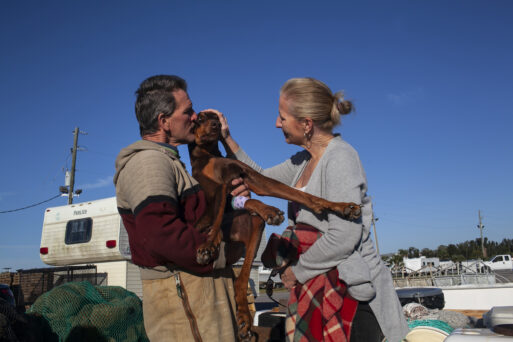
Saying goodbye
The third budget is their physical budget. For example, I had a few clients with rheumatoid arthritis in their hands, so asking them to give their dog or cat injections was too difficult. Or they can’t give oral medication because they can’t physically catch their cat, shove it in their mouth and hold it closed. Or, there is a lot of difficulty when big dogs get older and experience mobility issues. Getting them up and down, moving them, cleaning them, it’s a big, physical task.
And the last but maybe most important aspect is the family’s emotional budget. So many times I have walked into a home and the person tells me that the animal is the last thing they have of their husband, wife, mom, dad, child — I’ve heard it all. The last remaining tie they have to someone. And that can make people want to wait until the very end because they don’t want to lose that tie, or else they make the decision even sooner because they can’t handle the emotional rollercoaster of waiting.
In your experience, has there been any advice that has helped those owners who feel like it isn’t their “place” to make the decision to humanely euthanize?
People will often say they wish their pet would tell them when it was time. And I tell them, he is. They can’t say it in the same way, but it’s in a way like a sick zebra, or the antelope that just sits down on the plains, or the one that is laying down because they can’t get around. That is the way mother nature has designed it: when an animal is down, unable to move and get around, something will take them, whether it’s the illness or a predator. That’s mother nature’s way of not making them go on and suffer and suffer and suffer.
With pets, we give them shelter and food and water, medical care, their every whim, and we mistakenly drag this thing out when that isn’t actually what mother nature intended. That helps a lot of people, because they want their pet to go ‘naturally.’ I tell them, this isn’t natural. Nothing about what we’re doing with domesticated animals is natural. Natural death is much quicker than this. And that’s where euthanasia needs to step in: it provides death where death is already going to occur, and avoids unnecessary suffering.
What is the most rewarding aspect of the services Lap of Love provides to families with pets?
It’s our job to help the families consider their different budgets and help them achieve their goals for their pet’s remaining time. Most veterinarians don’t have that kind of time. To walk people through the decision-making process, that’s really where the gold is, helping them through it; and then it gets done the way they want it to.
And afterwards, they are just left with their grief, which is our own personal journey, for all of us. It’s just grief, but the grief is so much better journeyed without guilt. So that’s my job, as a veterinarian, is to reduce that guilt as much as possible.
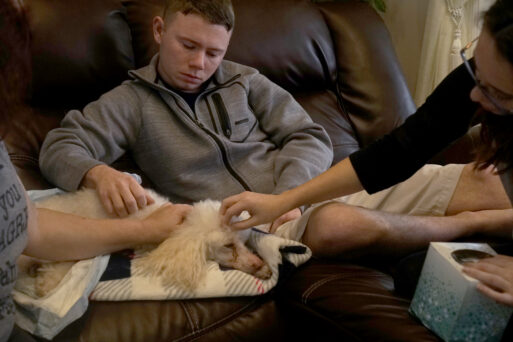
Has there been anything that has surprised you?
You know, every family will have different reasons for making the decision to euthanize. I found this one family in particular – they had a dog and he got osteosarcoma. Bone cancer. They went to the veterinary oncologist and they got me involved when it was time for hospice, and they just did everything right, with pain management etc. They were told from the beginning that their dog would have about six months left to live after his diagnosis, and it was amazing, we ended up euthanizing the dog almost six months to the day. Then, almost three years later, they found out their next dog had osteosarcoma, too. And they called me and were like, “Can you be here today or tomorrow?” Because they couldn’t go through that again. It was so long and traumatic. So to me, that’s a perfect example of somebody waiting as long as they could, and then, under the same circumstances saying, “I don’t want to do that again.” Saying goodbye for that long takes energy, emotion, it drains all of those budgets.
So it’s an interesting phenomenon that I didn’t know when I first graduated, but realized after a few years of doing this. As people go through it, in subsequent times they tend to make the decision to euthanize sooner and sooner.
It makes me wonder if there’s a corollary to humans there, too. I’ve gotten pulled into conversations about human euthanasia, and it’s really fascinating. There’s one moment during the euthanasia process, right before or right after we’ve given the euthanasia injection, when their pet is so calm and relaxed. And it’s just the perfect state of peacefulness. The owners will always look at us and say, “I wish we could do this for humans. I wish my grandma could have had this. I wish my mom had this.” Because they suffered so much at the end, even in a hospital. And I hope one day that the human medical field comes to us to discuss those parameters, because we know how to do it.

 Lessons From a Veterinarian: How to Know When It’s Time To Say Goodbye To Your Pet
Lessons From a Veterinarian: How to Know When It’s Time To Say Goodbye To Your Pet


 First the Wealth Gap, Now the U.S. Has a Growing Health Gap
First the Wealth Gap, Now the U.S. Has a Growing Health Gap

 Our Annual Seven Holiday Gifts for Someone Who Is Grieving, 2024 Edition
Our Annual Seven Holiday Gifts for Someone Who Is Grieving, 2024 Edition














